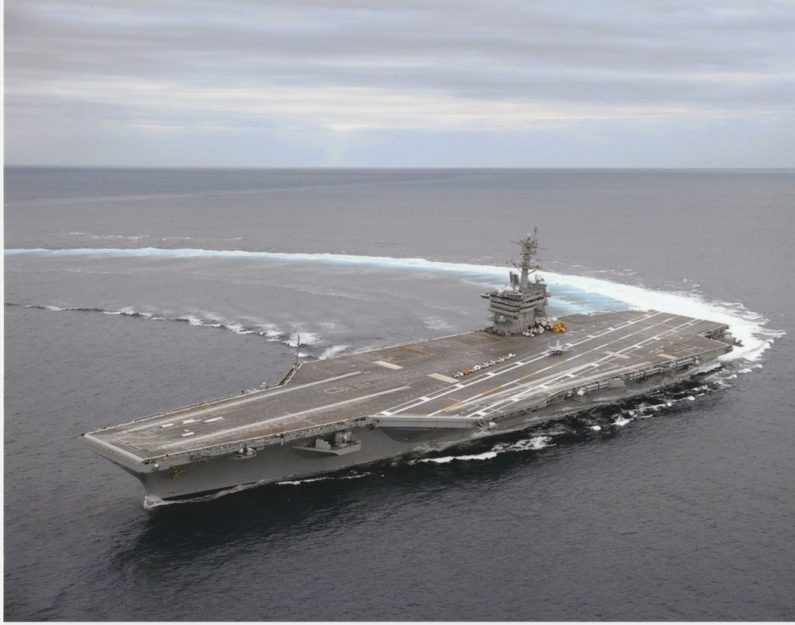“Finn felt the shift in the soles of his feet. The ship was pulling around…” — Steel Fear, chapter 19
It was a cold Tuesday morning on January 8, 2019, when I set foot on board the USS Abraham Lincoln, a 90,000-ton Nimitz-class US Navy aircraft carrier. A warship roughly the size of the Empire State Building lying on its side that, when populated and out to sea, would carry some six thousand men and women.
What if one of them was a serial killer?
What if members of the crew — an officer, a pilot, a lowly E-2 — started to disappear, one by one, and nobody knew why or how? What if there were shark on board? Not the kind with fins and teeth but a shark in human form, just as silent and ten times as lethal? What would happen then?
That’s what I was there to find out.
More specifically, that’s what I was there to write about.
My assignment: learn everything I could about this floating city, its secrets and the danger lurking somewhere in its fifty acres of steel passageways and dimly lit compartments. Learn it all — because I was writing a book about it.
I absorbed some fascinating details on board the Lincoln that day.
For example, that the sailors hoard cans of Monster from the ship’s store to trade for other stuff like prison-yard cigarette packs.
That the rearmost point of the ship, called the fantail, is also one of the funkiest-smelling spots on board, because that’s where they go to toss all their organic garbage overboard.
That the nuclear-reactor-powered drive shafts that run the ship’s four brass pickup-truck-sized brass propellors run the full length of the ship, through a channel near the hull called “Shaft Alley.”
That an insanely complex sequence of events is immediately triggered if someone happens to fall, say, from the fantail.
First, the “Man overboard!” call goes out across the ship’s PA system. A complete muster (inventory of all personnel) is taken. The ship meanwhile executes a “Williamson turn” — an immediate hard turn that first puts the ship’s heading about 60 degrees from its original heading before turning hard back in the opposite direction until the ship’s heading is 20 degrees off from the direction opposite to its original heading to bring the vessel back to a point just upwind of the incident locus. That is, so you don’t run over the person you’re trying to save.
Exactly like the photo at the top of this blog post, which is a shot of the Lincoln itself doing exactly that.
A rescue effort is launched, led by Knighthawk helicopters and rounded out with RHIB teams with their inflatable boats. A team on the bridge plots a search grid, factoring in wind speed, current, number of daylight hours remaining, and much more, then skewing that grid into a diamond pattern to account for drift, which can be considerable. The other ships in the carrier’s strike group, which may be spread out over miles, all converge on the scene to offer aid if needed.
All the resources of the strike group’s thousands of personnel and billions of dollars of technology are thrown at the task of rescuing the overboard as quickly as possible so the person doesn’t drift away. Or get sucked into one of those pickup-truck-sized propellors.
Assuming they were alive when they hit the water.
Assuming they fell.
Rather than being, say, pushed.
Today is two years to the day since my visit with the crew of the Lincoln, and the answers to my questions are all there, in the pages of a new thriller called Steel Fear. My first novel. It comes out this July.
Keep your eyes on this spot.
Over the next few months, I’ll tell you all about it.


I FEAR I can’t wait to read it–I’ll just have to STEEL my resolve and be patient!!
Ditto on what Adrian said above. Hopefully nobody will STEAL my STEEL resolve!
Congratulations, John! Undoubtably, your novel will STEEL the attention of the masses. Books on the NYT best-seller list will have a new FEAR come July.
Glad to see you guys STEEL have a sense of humor, but how FEAR will you take it?
Takes a STEEL pair for sure to stalk a serial killer stealing around a STEEL city!
John, this is wonderful news! It’s sheer delight to read anything you write. However, I FEAR this will seem like a long wait.